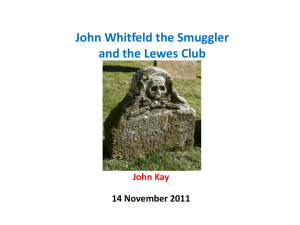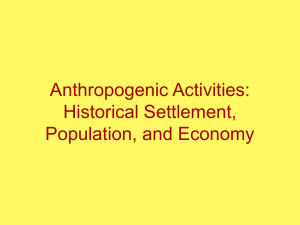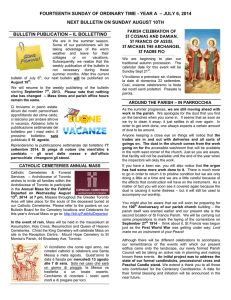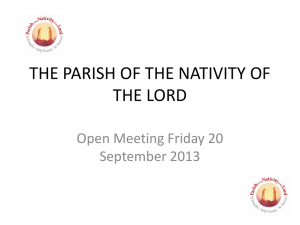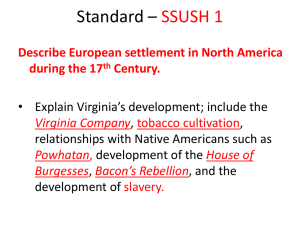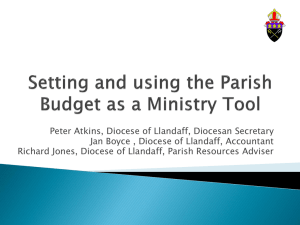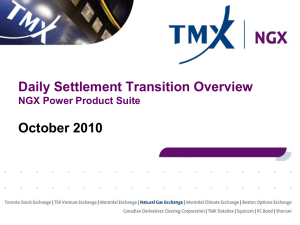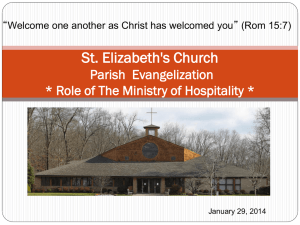LEWES HISTORY GROUP October 2009
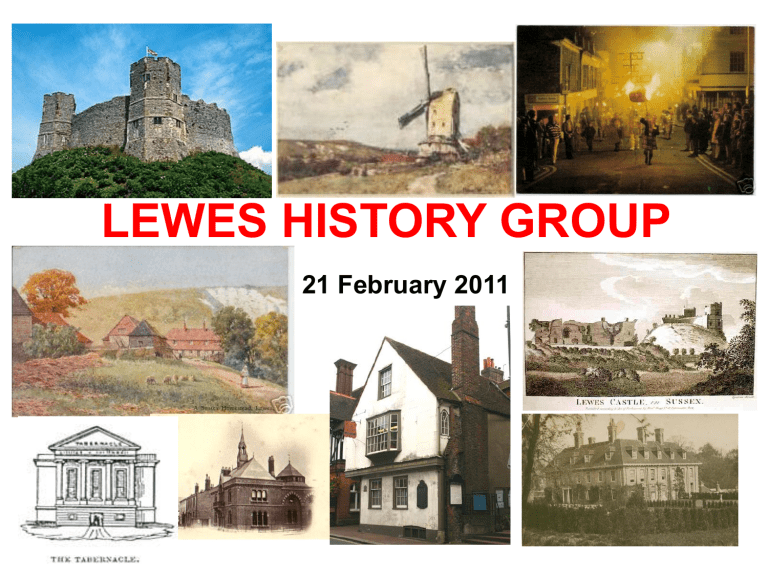
LEWES HISTORY GROUP
21 February 2011
Lewes History Group
Settlement Records in Lewes Parish Chests
John Kay
21 February 2011
Everyone had a settlement
Your parish of settlement determined which parish was responsible for your care if you needed help.
You started with your father’s settlement (if legitimate), and you kept that unless you acquired a new one.
You acquired a new settlement by:
• owning or leasing real estate above a specified value;
• serving a parish office, such as churchwarden or overseer;
• joining a new family, as an apprentice, or by living as an unmarried resident servant for a year.
A woman (but not any children she already had) acquired her husband’s settlement on marriage.
Any other parish could deport you back to your ‘home’ parish if it suspected you might need support, and they normally would do so if you became ill, or fell on hard times
Common types of settlement records
•
Removal orders to and from the parish – outgoing and incoming
•
Settlement certificates
•
Settlement examinations
•
Apprenticeship indentures
•
Illegitimacy records
Warrants to arrest putative fathers
Maintenance orders
Bonds to reimburse parish expenses
Settlement records in Lewes parish chests
St Anne St Michael St John-s-C Cliffe
Removal orders outgoing incoming
Settlement certificates
Settlement examinations
Apprenticeship indentures
33
25
1
3
2
100
89
94
18
84
19
10
47
2
17
Illegitimacy records 30 55 16 58
No settlement records at all survive in the parish records of All Saints, Southover or South Malling
158
66
139
32
70
Dates of surviving Lewes settlement records
<1750 1751-1800 1801-1834 >1834
Removal orders outgoing incoming
Settlement certificates
36
13
148
Settlement examinations 9
Apprenticeship indentures 100
Illegitimacy records 28
96
53
132
31
35
45
162
113
1
11
36
59
16
8
0
3
1
2
Which other parishes were involved?
Data for Lewes St Michael’s parish
Other Nearby Other Out of
Lewes parish Sussex county
Removal orders outgoing incoming
Settlement certificates
36
35
41
14
16
17
26
20
26
So over 40% were with other Lewes parishes
About 45% with other Sussex parishes
Just over 10% were out-county, mainly with neighbouring counties and London
15
14
7
Parish apprenticeships
Some examples, from St Michael’s
Apprenticeship indenture PAR414/33/1
Margrett Stearnes apprenticed to William Ockenden of Barcombe, tailor
7 Jun 1652
Apprenticeship indenture PAR414/33/7 15 Aug 1672
Mary Devall, daughter of Robert Devall, late of Lewes St Michael, victualler, deceased, apprenticed to William Jackson of Southwark St Thomas, weaver, and his wife Anne
Apprenticeship indenture PAR414/33/9 25 Nov 1672
Elizabeth Devall, daughter of Robert Devall, late of Lewes, deceased, to Thomas
Fitzharbert of Ringmer, yeoman
Apprenticeships were generally to a master in another parish, and transferred settlement to the new master’s parish.
The parish paid a premium, typically £10.
Some examples, from St Michael’s
Apprenticeship indenture PAR414/33/20 9 Jun 1704
Ralph Eager, son of Stephen Eager, late of Cliffe, St Thomas, deceased, bargeman, apprenticed to Thomas Faulkener of Lewes St Peter and St Mary Westout, blacksmith
Apprenticeship indenture PAR414/33/21 30 Apr 1705
Walter Apted apprenticed to Thomas Harman of Lewes St Peter and St Mary
Westout, pipemaker
Apprenticeship indenture PAR414/33/22 14 Feb 1706/7
Gervase Murray apprenticed to Richard Langridge of Fletching, carpenter
Typical examples. Stephen Eager lived in Cliffe, but by a settlement certificate from St Michael’s.
Some examples, from St Michael’s
Apprenticeship indenture PAR414/33/12
John Brinkhurst, apprenticed to Henry Paine of Streat, yeoman
19 Sep 1683
Apprenticeship indenture PAR414/33/13
Ann Brinkhurst, apprenticed to Henry Paine of Streat, yeoman
19 Sep 1683
In this unusual case two children, probably from the same family, were apprenticed together. Ann the daughter of John & Sara Brinkhurst had been baptised at Lewes St Michael on 11 Apr 1669, so she was about 14.
Apprenticeship indenture PAR414/33/59 29 Apr 1761
George Watson (aged 9) apprenticed to John Watson the elder of Maresfield, husbandman & farmer
Apprenticeship indenture PAR414/33/60 13 Jun 1761
Thomas Watson (aged 7) apprenticed to Henry Watson of Newick, husbandman
Probably “apprenticeships” within a family.
Some examples, from St Michael’s
Apprenticeship indenture PAR414/33/36 6 Feb 1741/2
Sarah Breach (aged 9) apprenticed to John Edwards of Cuckfield, husbandman
Apprenticeship indenture PAR414/33/37 3 May 1741
John Gilmore (aged 12) apprenticed to William Headley of Newhaven, mariner
Apprenticeship indenture PAR414/33/38 22 Aug 1741
John Breach (aged 12) apprenticed to John Hemsley of Westmeston, yeoman
Apprenticeship indenture PAR414/33/39 24 Aug 1741
Lucy Denman (aged 12) apprenticed to Jared Denman of Lewes St Mary & St Peter
Westout, carpenter, to be taught housewifery
Apprenticeship indenture PAR414/33/41 71 Sep 1743
Thomas Breach (aged 13) apprenticed to George Gibson of Middlesex, cook
Apprenticeships were typically young teenagers, but could be under 10
Some examples, from St Michael’s
Apprenticeship indenture
William Petow
Apprenticeship indenture
Sarah Tanner
Apprenticeship indenture
James Percell (aged 16)
Apprenticeship indenture
Hannah Shelton (aged 10)
PAR414/33/56
PAR414/33/57
PAR414/33/58
PAR414/33/61
8 Feb 1758
20 May 1758
15 Sep 1760
226 Apr 1762
Were all apprenticed to the same man:
Thomas Harding of London, St Andrew Hubbard, feltmaker.
An example, from St John-sub-Castro
Apprenticeship indenture PAR412/33/7 3 Jun 1721
Thomas Blaber was apprenticed to Benjamin Mott of Ringmer, flax-dresser
Benjamin Mott will have received a premium of about £10 to instruct
Thomas Blaber in his craft, the first step in linen manufacture, then a rural craft.
While Thomas Blaber may have proved an exemplary employee,
Benjamin Mott’s decision cost Ringmer parish hundreds, if not thousands, of pounds in supporting Blaber’s, generally rather less than satisfactory, children, grandchildren and great-grandchildren.
Some examples, from St Michael’s
Apprenticeship indenture PAR414/33/30 25 Feb 1726
Benjamin Longley apprenticed to Jonathan Forward of London, merchant, to serve in
His Majesty’s plantations in America
Apprenticeship indenture PAR414/33/69 20 Jan 1783
Richard Watson, son of Richard Watson, deceased, apprenticed to John Greathead master of 'The Acorn', lying at Newhaven, to be instructed as a mariner
Apprenticeship indenture PAR414/33/78 & 79 28 Dec 1811
James Parker (10) and William Cole (15) apprenticed to Robert Metcalfe of Uckfield, cotton manufacturer
Some apprenticeships appear more adventurous than others
Some examples, from St Michael’s
Apprenticeship indenture PAR414/33/71 9 Sep 1784
Thomas Davis, son of Mary Davis, widow, apprenticed to William Gwynne of Lewes
St Peter and St Mary Westout, clerk, to learn reading and writing
Some parish apprenticeships appear to offer real opportunities to the apprentice.
However, careers in surgery and the law, and provisions such as the master guaranteeing that on completion the apprentice would be made a freeman of the City of London, are confined to the more expensive private apprenticeships.
Removal Orders
Removal Orders
Could affect any family settled elsewhere than the parish where they lived, but especially any family thought likely to require social assistance or otherwise undesirable, and especially:
• the unemployed, or under-employed
• anyone dependent on parish social security
• widows with children, or orphaned children
• wives and children of soldiers or convicts
• anyone ill
• people too old to support themselves any longer
• single women who became pregnant
• beggars and other undesirables (though tramps were generally given a shilling or two to continue on their way)
Not every order was enforced, providing the “home” parish accepted responsibility.
Some examples, from St Michael’s
Removal order from Lewes St Michael PAR414/32/2/1
Thomas Acton, his wife and four small children, to Southover.
10 Apr 1662
Removal order from Lewes St Michael PAR414/32/2/45 20 Apr 1793
Philadelphia, wife of George Gilbert, a private soldier in the 11th Regiment of Light
Dragoons, and their son, Isaac, to Heathfield.
Removal order from Lewes St Michael PAR414/32/2/59
Elizabeth Wise, singlewoman (pregnant), to Lewes St John-sub-Castro.
20 Jun 1812
Removal order from Lewes St Michael PAR414/32/2/83 3 Jun 1828
Margaret Baldwin, wife of James Baldwin, who has been sentenced to transportation, and children Alfred (4), James (2) and Elizabeth (7 months), to Ticehurst; endorsed with suspension and late execution of removal due to sickness; includes account for the cost of nursing Margaret during her illness.
Some examples, to St Michael’s
Removal order to Lewes St Michael PAR414/32/3/2
William Holland and his wife, Sarah, from Southover.
11 Jan 1732/3
Removal order to Lewes St Michael PAR414/32/3/3
John Breach and his children John, Thomas & Sarah, from Burwash
11Apr 1738
[with a note from the Burwash overseers about the settlement of the children of John
Breach, shoemaker, who had left his family; copies of the 1729-1733 baptisms of the children of John & Sarah Breach at Burwash; and a bill for the children’s care there].
Removal order to Lewes St Michael PAR414/32/3/7 11 Jul 1741
Elizabeth Denman, widow, and her daughter Lucy (12) from Lewes St John-sub-
Castro.
Removal order to Lewes St Michael PAR414/32/3/53
Elizabeth Harris, singlewoman, pregnant, from Brighton.
23 Jul 1808
Removal order to Lewes St Michael PAR414/32/3/84 11 Oct 1832
James Lintott, blacking maker, his wife Mercilla, and children James (6) and Elizabeth
(2) from Norwich.
Some examples, from St Michael’s
Removal order to Lewes St Michael PAR414/32/3/8 29 May 1759
Ann Butler (11) and Elizabeth Butler (5), the children of James Butler, deceased, and his wife Elizabeth (now ill and unable to be moved), from St Martin in the Fields,
Middlesex
Removal order to Lewes St Michael PAR414/32/3/9 18 Apr 1768
Elizabeth Butler, singlewoman (14), a vagabond, from Westminster, St Paul Covent
Garden; includes examination stating that her father was James Butler
Removal order to Lewes St Michael PAR414/32/3/10 18 Apr 1768
Ann Butler, singlewoman (21), a vagabond, from Westminister, St Paul Covent
Garden; includes examination stating that her father was James Butler
“One would imagine that all the prostitutes in the kingdom had picked upon the rendezvous”
Sir John Fielding
Some examples, from St Michael’s
Removal order from Lewes St Michael PAR414/32/2/28 10 Feb 1772
Samuel Conley, one of the sons of Benjamin Conley, deceased, to Wapping St John;
Samuel was born in Lewes St Michael in 1719 where his father was residing by virtue of a settlement certificate dated 28 May 1707, issued by Wapping St John.
Settlement certificates could have long-lasting impact
Samuel Conley had been born in St Michael’s and apparently lived there for over half a century, but was still liable for deportation to his
“home” parish of Wapping.
Some examples, from St Michael’s
Removal order to Lewes St Michael PAR414/32/3/12 28 Apr 1770
Hannah Western, a vagabond, from Devon House of Correction; includes an examination stating that she is the wife of William Western, a whitesmith
People could travel considerable distances
[And on 23 Jul 1770 Lewes St Michael obtained an order removing Hannah Weston to Crediton, Devon]
A removal order that has not survived deported William Weston, a journeyman whitesmith aged 35 who had fallen ill, from a parish in Yorkshire to St
Michael’s. His arrival in Oct 1773 after this long journey in a small open cart, covered only by a little straw and a coat of lice, emaciated and unable to move, was witnessed by Thomas Paine, who as Humanus fulminated about the inhumanity of the system in the Lewes Journal. William Weston died very shortly after his arrival “home”.
[source: Colin Brent, ‘Tom Paine at Bull House’, Sussex Archaeological Collections , 147, p.158, via Paul Myles]
Some examples, from St Michael’s
Removal order to Lewes St Michael PAR414/32/2/71 12 Oct 1821
Samuel Jenner the elder, his wife Ann (his present wife), Lucy (aged 17) his daughter by his first wife formerly Ann Whiting, widow, Samuel (aged 13), the son of his first marriage), and children John (5), Edward (3) and Elizabeth (11 months), children of his second marriage, all from Lewes St John sub Castro.
One settlement order could transfer responsibility for a large and complex, and potentially expensive, family.
An example from St Anne’s
Removal order from Lewes St Anne PAR411/32/2/37 16 Nov 1830
Martha Smith (8) and Joseph Smith (4), the illegitimate children of Martha the wife of
Joseph Smith, to Horsham.
Removal order from Lewes St Anne PAR411/32/2/38 16 Nov 1830
Martha Smith, the wife of Joseph Smith, a prisoner in Horsham gaol, and her daughter Susannah (2), to Horsham.
Members of what we would today consider a single family might have different settlements. If a man married a woman who already had children, she would acquire his settlement, but her existing children would not.
Thus a widow who re-married might be separated from the children of her first marriage. Illegitimate children would also be left behind when their mother married, even if the new husband was their father. In this case, both Martha and her illegitimate children happened to have the same settlement.
Another example from St Anne’s
Removal order from Lewes St Anne PAR411/32/2/39 10 Jun1834
Mary Twigg, otherwise Mary Divall, pregnant with an illegitimate child, and the wife of
John Divall, now on board the hulks as Gosport under sentence of transportation, to
Ringmer.
Transportation left a man’s wife and family in limbo. They were very unlikely to meet again, or even hear of each other again.
A woman was unlikely to be able to earn enough to support a family. The wife left behind could not easily “move on” to another man. If she tried to, as Mary
Divall evidently did here, the parish officers could forcibly deport her to her legal husband’s parish, where her new man would be unlikely to be able to follow.
Settlement examinations, from St Michael’s
Settlement examination
Edward Cossam
PAR414/32/4/1 13 Jan 1752/3
Born in Ringmer. [Baptised at Ringmer 1725]
Hired as a yearly servant to Thomas Relfe of Ripe, 1749-50.
Married and since lived chiefly in Lewes St John sub Castro & St Michael.
Holds a settlement certificate from Ripe.
Settlement examinations in particular often contain details of lives that would otherwise be entirely unrecoverable
Settlement examinations, from St Michael’s
Settlement examination PAR414/32/4/6 18 Jul 1770
Ann Chapman
About Oct 1760 she married Thomas Robson, a soldier in Mordaunt’s Light Troop at
St Michael’s.
She marched with Robson to Croyden, Surrey, where she had a daughter.
She then went to Canterbury with Robson, where he deserted the troop (and her).
She returned to St Michael’s, but was removed to Lamberhurst, Kent.
It was then proved that Robson already had a wife when he married her.
So Ann, and her child, are settled in St Michael’s, where they have since lived.
Settlement examinations in particular often contain details of lives that would otherwise be entirely unrecoverable
Settlement examinations, from St Michael’s
Settlement examination PAR414/32/4/16 c.1815
[from watermark]
William Dicker
Residing in Lewes All Saints.
Born in Ringmer, where his father legally settled.
About 30 years ago hired the house in Lewes St Michael where Mr Smart the mealman now resides. He hired it from Mr Trinity, deceased, land steward of the late Mr Knott.
Rented a house in St Thomas, Cliffe.
Lived in Lewes St John, rented a house in Russell Row from Serjeant Kempe; while he was there his wife and the greatest part of his family died.
He then went to Brighton and married Eleanor Smith, who kept a small grocer’s shop in a small house or cottage built on wheels, which he later sold to Mr Piercy of North Street.
Settlement examinations in particular often contain details of lives that would otherwise be entirely unrecoverable
Settlement examinations, from St Michael’s
Settlement examination PAR414/32/4/14 6 Jan 1825
Ann Bailey
She was born in Lewes St John, her maiden name Clark.
She was a servant to the late Henry Verrall of St Michael’s for 3 years.
While there she married Collin Terrill, a soldier quartered there.
He went to America, where she believed that he died.
She was married again in Bloomsbury, London, to Thomas Bailey, a tailor, and lived near Tottenham Court Road.
She separated from him 20 years ago and does not know his place of settlement.
It was not enough to show a person’s settlement was not in the parish where they lived. To remove a person the parish had to establish where they were really settled.
Settlement examinations, from St Michael’s
Settlement examination
John Williams
PAR414/32/4/11 28 Dec 1807
Now a private soldier.
Born in “Bethgelart, Carnarvon”.
At age 15 was hired by John Hughes of Chester Trinity.
(does not specify whether he completed a year’s service)
Has this day married Lucy Gates of Lewes St Michael, singlewoman.
Marriage could transfer your settlement to a place hundreds of miles away, and which you had never visited
Bastardy Records
Bastardy Records
Parish strategy 1:
Transfer the problem to another parish, if at all possible, using the settlement laws.
Parish strategy 2:
Avoid illegitimate children being born, by “encouraging” a marriage
Parish strategy 3:
If all else fails, make sure the father contributes to the cost.
Records left
• Examination of expectant mothers
• Warrants for the parish to arrest putative fathers
• Maintenance orders
• Bastardy bonds
Some examples, from St Michael’s
Maintenance order PAR414/34/3/4 8 Feb 1806
George Newman late of Lewes, coachman, for the support of the daughter of Frances
Davey, born on the 21 Dec [1805] at the poor house
Warrant to arrest putative father PAR414/34/2/9 22 Jul 1807
Edward Hudson of Lewes St Peter and St Mary, labourer, father of the bastard son of
Elizabeth Goodyear of Lewes St Michael, which was born in Horsham following a removal order which was later quashed
Maintenance order PAR414/34/3/6 24 Jul 1807
Edward Hudson for the support of the son of Elizabeth Goodyear, born 4 Dec 1805 at
Horsham
Bastardy Bond PAR414/34/4/4 14 Oct 1709
Bastardy bond binding William Lane, Lewes St Peter and St Mary Westout, gentleman, and Elizabeth Payne, widow.
Bound in £50 for the support of the child of Elizabeth Kingers fathered by Lane
Some examples, from St Anne’s
Removal order to Lewes St Anne PAR411/32/3/15
Frances Crossland the younger was removed from Chichester
14 Aug 1826
Removal order to Lewes St Anne PAR411/32/3/19 26 Apr 1828
Frances Crossland, singlewoman, pregnant, was removed from Chichester St Martin
Warrant to arrest putative father PAR411/34/2/12 12 Jul 1831
George Budd of Chichester, cabinet maker, father of the son of Frances Crossland born 13 Aug 1828
Maintenance order PAR411/34/3/9 26 Jul 1831
George Budd of Chichester, cabinet maker, father of the son of Frances Crossland born 13 Aug 1828
Maintenance order PAR411/34/3/12 6 Mar 1832
John Triggs of Chichester, whitesmith, father of the daughter of Frances Crossland born 14 Oct 1831
Some recidivists are encountered
Some examples, from St Anne’s
Warrant to arrest putative father PAR411/34/2/5 7 Dec 1819
George Ade, late of Lewes, baker, father of the son of Susannah Lower born 13 Oct
1819, with a note that the child, Jeremiah Lower, died 17 Nov 1825.
Maintenance order PAR411/34/3/4 2 May 1820
George Ade, late of Lewes, baker, father of the son of Susannah Lower born 13 Oct
1819
Maintenance order PAR411/34/3/6 26 Feb 1822
Richard Leggatt of Lewes St Michael, bricklayer, father of the son of Susannah Lower born 6 Jan 1822
Maintenance order PAR411/34/3/11 3 Mar 1832
James Lambert of Brighton, bricklayer, father of the daughter of Susannah Lower born 9 Nov 1831, with reference to payment of the balance owing in 1835
Warrant to arrest putative father PAR411/34/2/13 19 Mar 1833
James Lambert of Brighton, bricklayer, father of the daughter of Susannah Lower
Some recidivists are encountered
How reliable is our information?
All may not be as it seems – there may be key information that is unrecorded or deliberately hidden.
What proportion of the overseers’ activities is actually recorded in the surviving information? Are the records of the parishes with good collections substantially complete, or are they just the tip of the iceberg?
Records survive only for cases that resulted in formal action. Are they too just the tip of the iceberg?
How reliable is our information?
Where both parishes have large numbers of removal records, we can cross-check, to determine correlations.
Exporter Both Importer Total only only
St Michael to Cliffe 2 2 0 4
Cliffe to St Michael
St Michael to Ringmer
5 4 2 11
0 0 1 1
Ringmer to St Michael 1 3 1 5
Cliffe to Ringmer 1 1 0 2
Ringmer to Cliffe 1 0 0 1
So, for a total of 24 deportations between these three parishes for which at least one parish retained records, both parishes retained records in 10 cases (42%).
